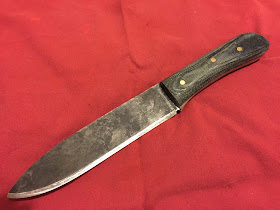Readers have shown an interest in the subject of historic butcher,
slicing and boning knives. These are the
knives that have been in families for a generation or two, perhaps even
more. Every homestead, farm and ranch
has a collection of these knives. When a
goat, hog, deer or even white-winged dove, Eurasian collared dove, turkey, quail or
duck are collected for the pot these thin-bladed knives are invariably pulled
from the drawer and called on to do most of the work. Make a barbecue and these very same knives see
all the action. Savvy campers and
woodsmen rely on these types of knives for work around the spit or grill. So it was a century ago when pioneers,
woodsmen, mountain men and hunters lived isolated lives far from established cities. Woods roamers in generations past sought
practical and serviceable knives. Even
today in remote parts of the world the needs remain the same. People usually can’t afford the luxury of
scores of knives nor do they want to burden themselves with needless
stuff. A knife is a tool and almost
certainly has one primary purpose: Food preparation. Vegetables for caldo, thin slices of bacon for the griddle, cuts of cabrito; the list is extensive. But the knife selection is basic. The most used knife seems to be the
long slicer followed by the boning knife with the classic butcher knife at the ready.
If folks send me photos of their family's old historic butcher, slicing and boning knives I'll post them in this gallery section. It helps if photo submissions are accompanied by a brief (very brief) history of the knife, the make and blade length.
Jordon Marston wrote me the following letter and sent this photo:
Jordan from the Yukon:
Below are two views of JR Guerra's grandmother's butcher knife. JR says his mother recalls his grandma using the knife on their ranch in the late 40s and 1950s to butcher goats, hogs and even large cattle. For the record, the knife is a Blackjack 14 with a 7.5" blade and overall length of about 10 inches. In the photos below the old butcher knife sits alongside one of JR's hunting knives and a Tramontina 12" machete.
Here's a photo of an ancient boning knife that belonged to JR's grandmother. I remember my granddad owned several knives that looked exactly like the one in the photo below.
John Tawes sent several photos of his historic knife collection. Mind you, these are using knives and the marks and patinas show proof of that fact. I found one photo particularly intriguing.
John Tawes sent several photos of his historic knife collection. Mind you, these are using knives and the marks and patinas show proof of that fact. I found one photo particularly intriguing.
Note the bolster on the large butcher knife. John made no mention of what make of knife this is but it looks to be made of high carbon steel with a full tang. The sheath above this old knife appears to be rawhide. Also note the boning knives to the right. I've seen boning knives that have been sharpened thousands of times. After years of use they end up looking like fish filleting blades. The hook knife on top also caught my eye but that's for a different discussion.
Above is another look at John's butcher, slicing and boning knives. All of them filled with character and each telling a story of years of service preparing food for families across the land.













